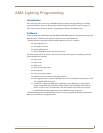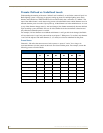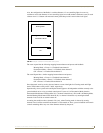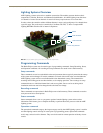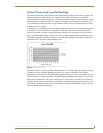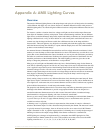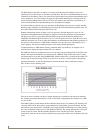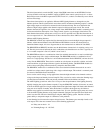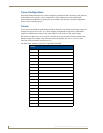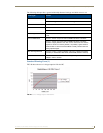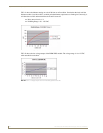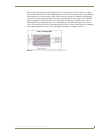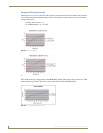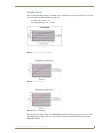
Appendix A: AMX Lighting Curves
45
RE-DM4 and RE-DM6 RADIA Eclipse Dimmer Modules
This third characteristic controls the RLY output of the RDM connections on the RE-DM4. Previous
versions of Radia would turn on the RLY outputs at INPUT (from control system) levels of 1 or above.
Radia Eclipse turns on the RLY output at the OUTPUT level of 1, so that it can effected by curve choices
and low end settings.
These three characteristics are applied to different AMX Lighting dimmers to change the way the
dimmers perform. The first characteristic most often used for incandescent dimming requires a variable
high-voltage output to one Hot wire connected to the incandescent lamp. The curve determines the
amount of high-voltage applied to the dimmer's output in relation to the control level. The second
dimmer characteristic applied to low-voltage output of the AMX RDM-HDC module is commonly used
for fluorescent ballasts that require a low-voltage control signal to vary the output of the ballast. The
third dimmer characteristic merely turns a relay on or off at a specified level. This third characteristic is
set at an output level of 1. The combinations of these characteristics allow AMX to tailor the outputs of
different AMX Lighting dimmers.
The RDM-INC module only requires the first characteristic that controls the high voltage output of a
dimmer. All the internal dimmers in the RE-DM4 and RE-DM6 also use the first characteristic to
determine dimmer output. All curve diagrams that use this characteristic are labeled in Volts RMS.
The RDM-SWM and RDM-ZC modules uses the third dimmer characteristic of switching a relay on or
off. The relay turn on level indicates the level at which the switch module turns on. This is typically set
to 1. A notable exception is Curve N, which is set at Level 9.
The RDM-FDB module uses a combination of the first and third characteristics to send a variable high-
voltage output along with a single switched output. The RDM-FDB module is a combination of two
devices in a single package. One device is an incandescent dimmer like the RDM-INC, and one device is
a relay like the RDM-SWM. These devices combine to switch power on and off to a ballast, and at the
same time deliver a high-voltage reference signal to the dimming ballast. The RDM-FDB module also
works with several lighting interfaces made by companies other than AMX.
The RDM-HDC module uses a combination of the second and third dimmer characteristic to send a
variable low-voltage control signal along with a single switched output. This module is commonly used
for control of dimmable fluorescent ballasts.
Curves can be used for energy-saving applications where the high end needs to be trimmed to reduce
voltage to the lamps and thereby increase lamp life. They can also be used to reduce the dimming range
of some fluorescent ballasts, which can prevent premature failure of the ballasts and lamps.
The AMX Lighting system now offers over 12 ways to alter the performance of the lighting fixture by
digitally changing the way the dimmer responds. Using the RDM-HDC module, for instance, to control
an 0-10 volt ballast applied to a single compact fluorescent light fixture might 'look' better when dimmed
using one curve instead of another. After the furniture is installed, the designer may decide that a
different curve applied to certain fixtures has a better 'feel.' It is now possible to apply many new curves
to all the AMX Lighting dimmers using simple commands. Designers and specifiers have much more
control over the look and feel of their designs using the AMX Lighting system. Installers will have
greater ability to temper the output of a dimmer to avoid problems.
As the dimming level increases the output voltage increases. The dimmer goes smoothly from 0 to 120
volts output. This is the most common curve used in dimming applications.
Relay turn on level = 1%
Dimming Range = 0 - 120 VAC.



